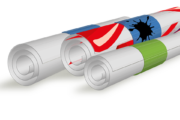My Passive Income Plan to Financial Freedom
In my 7 year plan to one million dollars, I have mapped out my journey to financial freedom and have explained how I intend to get there. Unfortunately, one crucial detail that was left out of the equation was my consideration in passive income.
It is sort of ironic how I intend to be financially free but have no solution for paying my bills and expenses. Here is how I plan to incorporate passive income into my financial journey:
Passive income vs. future expenses
In order to determine how much passive income I will need to retire by 2020, I would need to figure out my potential expenses first. Here is a quick prediction of my future expenses:
- My primary residence ($1,800)
- Mortgage ($1,000)
- Property tax ($300)
- Utilities ($300)
- Insurance ($50)
- Cable & phone ($150)
- Food ($200)
- Spending & travel money ($1,000)
- Savings ($500)
As long as my passive income surpasses my expenses, I will be on the fast track to one million dollars. From the list I just came up with, my passive income will need to total $3,500 for me to be considered financially free.
These numbers assume that I will still have a mortgage by then. If not, my numbers won’t change. I’ll just allocate the additional $1,800 to recreational activities such as travelling and crossing off my 101 things to do when I achieve financial freedom.
Passive income distribution by 2020
Monthly Breakdown
- Dividends: $1,000
- Portfolio growth: $500
- Business: $1,250
- Real estate cash flow: $750
Total Monthly Passive: $3,500
Annual Breakdown
I have included an annual breakdown because I believe that it will be quite difficult to maintain the monthly quota. Stocks and ETFs can be quite hard to predict. This is why the annual numbers will be the focus of my investments.
Note: These numbers are just my monthly numbers multiplied by 12.
- Dividends: $12,000 (28.57%)
- Portfolio growth: $6,000 (14.28%)
- Business: $15,000 (35.71%)
- Real estate cash flow: $9,000 (21.44%)
Total Annual Passive: $42,000
Moving forward from here
Dividends
I know I have been debating on whether to invest in dividends or ETFs a lot on my blog. However, seeing how dividends play a big role in my passive income goals, I will now focus on a dividend growth strategy for my TFSA.
Portfolio growth
On the other hand, my RRSP and non-registered cash accounts will focus on stable ETFs and high risk stocks that have the potential for tremendous gains. 🙂
Perhaps, I will even allocate a portion of my RRSP or non-registered accounts for dividend stocks to meet my 2020 quota should the room in my TFSA not suffice.
Business
Creating a comprehensive business plan is on my long list of goals for 2015 and something I haven’t gotten around to yet.
Some of my business ideas include: starting an online business, opening a fast food joint and creating a small startup software company. (more on what I decide to do later on)
Real estate cash flow
The plan is to start investing in high valued properties and to rent it out for positive cash flow. The intention is to own 5 properties by my deadline with one of them being my primary residence.
I will rent out the other 4. According to my passive income plan, these 4 will need to generate $750 a month. This averages out to $187 per property which is much more than just feasible.
That’s it! This concludes the passive income section of my plan. Although I am someone who likes to aim high and this plan may seem somewhat conservative to most people out there, having a solid foundation is always a good place to start.
Do you have any ideas for generating passive income? I would love to hear all about it.




It’s important to count the passive income, but my take is as long as you meet your retirement number, sell all of your asset, then move somewhere cheap, or pay off your principle home, living almost free, just taxes, maintenance, and insurance. Then the rest is just cost of feeding, clothing, entertaining yourself plus health insurance (just dental, since you’re in Canada :P)
The million road is just fine as is. :P. the retirement number probably less if you only need the essential. The million is the iconic.
That is what I thought about doing Vivianne. When I reach financial freedom, I thought about liquidating everything and start living minimally but I sort of want more than that. I think i’ll keep building assets at that point.
You have a good starting point in figuring out your expenses and a nice roadmap to achieve them. Those are quite a lot of properties that you are thinking of owning by 2020. Do you have experience in managing properties? Do you intend to manage by yourself?
R2R
Hi R2R, I can probably meet my quota for real estate positive cash flow with less properties. Currently, I do not have any experience in managing properties but I am trying to learn.
Hi Jeff
That seems a really sensible plan out there which I believe you are able to achieve.
The thing about liquidating the assets to fund your lifestyle until death is you have to be very accurate in your estimation of your expenses. You can use the 4% withdrawal rule though there are many things that requires you to put a cap on it for example expenses. For me, I would rather obtain financial independence through covering the expenses via passive income, just like the idea you have above. If possible, Id rather not touch the trees in case some unexpected things prop out at a later stage.
Thanks B. Liquidation is definitely a possibility but I am also considering building my net worth by not liquidating as well.
Jeff,
Seems like a solid plan – I like it!
One quick question though: how do you plan on living off the $500 worth of portfolio growth? If you sell off assets won’t you lose future dividend income?
Cheers,
NMW
Hi NMW, the $500 portfolio growth is only part of my passive income cashflow. I plan on generating $3,500 a month. That is a good point, I guess I wont liquidate and keep building up my assets.
Seems like a solid plan. I’m putting together a spreadsheet for calculating FI. I think I should incorporate business income in there as well.
Hi Tawcan, I look forward to reading all about it!
Jeff,
Seems like a pretty solid plan. However, the online business may be better suited to you if you are wanting to retire and spend time doing the things you want to do. The fast food joint may take quite a bit of your time. I like the plan! Good luck bud. I’ll follow along your journey!
Hi Andrew, I thought about starting an online business. That would be an excellent source of passive income and gives me the freedom to work from home.
I like how detailed your breakdown is. We have a plan for our early retirement but not to that level of detail. Part of the reason is we don’t plan to stay in the city we are currently living so our monthly costs for the future are just educated guesses. I look forward to seeing how it goes!
Hi Courtney! Thanks for checking my blog out. Your blog is awesome over there. I’ve book marked your blog and will be following along. 🙂